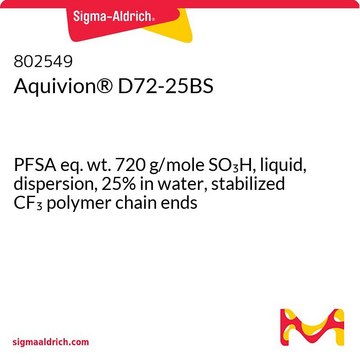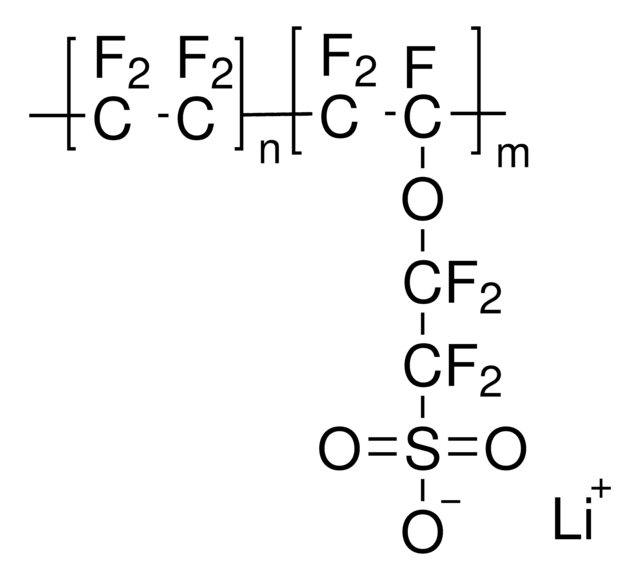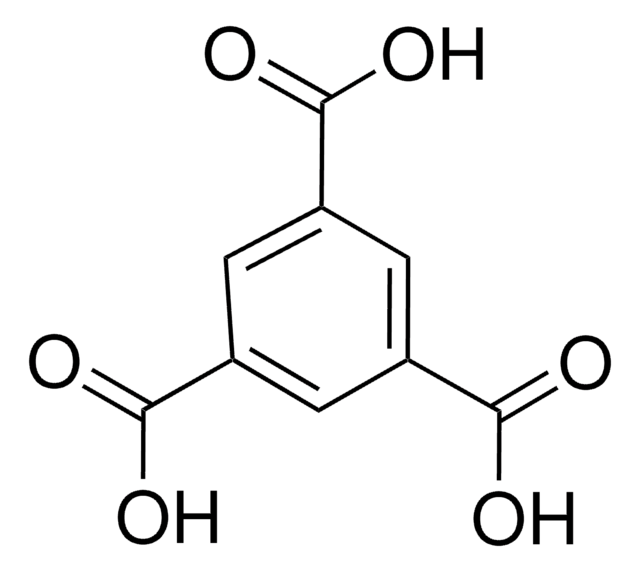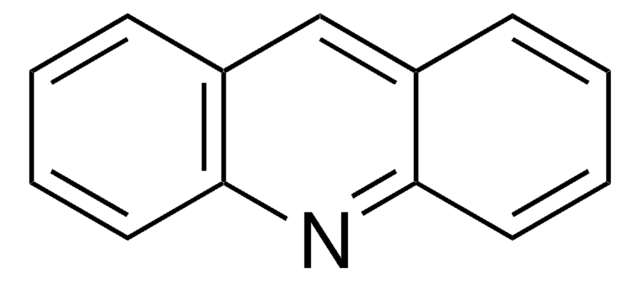802565
Aquivion® D79-25BS
liquid, dispersion, 25% in water, PFSA eq. wt. 790 g/mole SO3H, contains CF3 polymer chain ends as stabilizer
동의어(들):
Aquivion® SO3H-form, Tetrafluoroethylene-perfluoro(3-oxa-4-pentenesulfonic acid) copolymer, Ethanesulfonic acid
로그인조직 및 계약 가격 보기
모든 사진(1)
About This Item
Linear Formula:
(C4HF7O4S .C2F4)x
UNSPSC 코드:
26111700
NACRES:
NA.23
추천 제품
Quality Level
형태
dispersion
liquid
eq. wt.
790±20g/mol (SO3H)
포함
CF3 polymer chain ends as stabilizer
구성
25% in water
환경친화적 대안 제품 특성
Design for Energy Efficiency
Learn more about the Principles of Green Chemistry.
sustainability
Greener Alternative Product
농도
25±1 % (w/w)
density
1.14 g/mL
환경친화적 대안 카테고리
유사한 제품을 찾으십니까? 방문 제품 비교 안내
일반 설명
Aquivion® PFSA dispersions are derived from a short-side-chain (SSC) copolymer of Tetrafluoroethylene and Sulfonyl Fluoride Vinyl Ether (SFVE), CF2=CF2-O-(CF2)2-SO2F, industrially produced by Syensqo Group. The resulting perfluoropolymer features functional groups in their sulfonic acid form (SO3H). Aquivion® D79-25BS is a perfluorosulfonic acid (PFSA) ionomer dispersion with an Equivalent Weight (EW) of 790 g/eq. The EW of an ionomer represents the weight of the polymer required to provide 1 mole of exchangeable protons, inversely related to the ion exchange capacity (IEC). This dispersion is chemically stabilized, with a significant proportion of polymer end groups converted to an inert trifluoromethyl (CF3) configuration, enhancing the polymer′s lifetime. Aquivion® D79-25BS contains a polymer concentration of 25 wt% in a solvent system that is over 99% water and free of ethers.
We are committed to bringing you Greener Alternative Products, which adhere to one or more of The 12 Principles of Greener Chemistry. This product has been enhanced for energy efficiency and is intended for use as Proton Exchange Membrane (PEM) Fuel Cells. Click here for more information.
애플리케이션
The superacidity of Aquivion® PFSA resins, along with their high functional group concentration and electrochemical stability, makes them essential components in heterogeneous catalysts. Because of their excellent proton conductivity at low water uptake, these resins are used frequently in research as ionomer binders within the catalyst layers of proton exchange membranes (PEM) for fuel cells and water electrolyzers. Additionally, these resins are utilized in the fabrication of separator membranes (PEMs), either as stand-alone materials or reinforced with PTFE. They are also applied to the surfaces of specialty fluoropolymers to enhance wettability. Aquivion® D79-25BS, characterized by its short side chain and moderate equivalent weight, is a promising ionomer for achieving high catalyst activity. Ionomers with lower equivalent weights, such as D79-25BS, exhibit greater proton conductivities in electrochemical tests. This makes D79-25BS particularly suitable for use in PEM fuel cells and water electrolyzers. Additionally, it has proven to be an effective ionomer for heterogeneous catalysts in carbon dioxide and carbon monoxide electrochemistry. Researchers have successfully combined D79-25BS with platinum group catalysts and transition metal catalysts for various chemical reactions, owing to the ionomer’s resistance to highly aggressive chemical environments, including low pH, strong oxidants, and strong reducing agents.
특징 및 장점
- Very high concentration of functional groups for strong proton (or Na+, K+, Li+, etc.) conductivity
- High softening point for high temperature operation well above 80 ºC •
- Strong water retention for better fuel cell operation at low-humidity conditions for membranes or catalyst inks that are utilizing this dispersion material
법적 정보
Aquivion is a registered trademark of Syensqo Group
Storage Class Code
10 - Combustible liquids
WGK
WGK 3
문서
Advances in the electrochemical conversion of water to and from hydrogen and oxygen have principally been achieved through the development of new materials and by understanding the mechanisms of the degradation of proton exchange membrane fuel cells (PEMFC) during operation.
자사의 과학자팀은 생명 과학, 재료 과학, 화학 합성, 크로마토그래피, 분석 및 기타 많은 영역을 포함한 모든 과학 분야에 경험이 있습니다..
고객지원팀으로 연락바랍니다.







